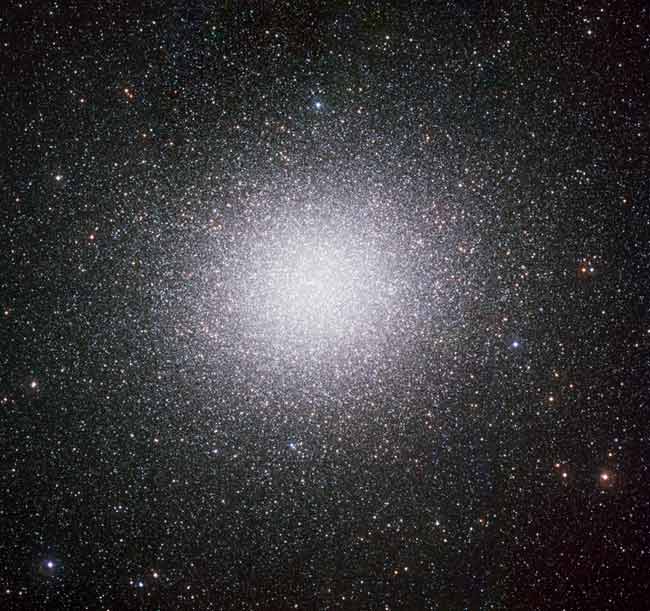New Image Details Jewel in Southern Sky

A clusterof stars called Omega Centauri shines like a jewel of the southern hemispherenight sky. It is visible to the naked eye, but through a telescope, millions ofstars are revealed to be part of this globular cluster.
A new imageshows OmegaCentauri in all its splendor.
The object,catalogued as a globular cluster, is roughly 17,000 light-years from Earth inthe constellation of Centaurus. It may in fact be the heart of what was once asmall galaxy that was destroyed in an interaction with our own Milky WayGalaxy.
OmegaCentauri is nearly as large as the full moon in our sky, though much dimmer. Itshines about magnitude 3.7, equal to a rather dim star on the astronomer'sscale of brightness. Omega Centauri is about 150 light-years across and is themost massive of all the Milky Way's globular clusters. It is thought to containabout 10million stars.
The newimage was made by the Wide Field Imager (WFI), mounted on the 2.2-meterdiameter Max-Planck/ESO telescope, located at the European Southern Observatory'sLa Silla facility, high up in the arid mountains of the southern AtacamaDesert in Chile.
OmegaCentauri has been observed throughout history. Both the great astronomerPtolemy and later Johann Bayer catalogued the cluster as a star. It was not untilmuch later, in the early 19th century, that an Englishman, the astronomer JohnFrederick William Herschel (son of the discoverer of Uranus), realized thatOmega Centauri was in fact a globular cluster, ESO astronomers explain.Globular clusters are some of the oldest groupings of stars to be found in thehalos that surround galaxies like our own Milky Way.
OmegaCentauri is thought to be around 12 billion years old. The entire universe issaid to be 13.7 billion years old.
Breaking space news, the latest updates on rocket launches, skywatching events and more!
Recentresearch into this intriguing celestial giant suggests that there is a mediumsized black hole sitting at its center. Observations made with the Hubble Space Telescopeand the Gemini Observatory showed that stars at the cluster's center weremoving around at an unusual rate. Astronomers concluded this was caused by thegravitational effect of a massive black hole with a mass of roughly 40,000times that of the sun.
Regulargalaxies typically have black holes weighing in at millions or even billions ofsolar masses.
- Video - 007's Big Telescope
- New Pictures Reveal 100,000 Galaxies
- AutomaticTelescope Spots Light-Speed Explosions

Space.com is the premier source of space exploration, innovation and astronomy news, chronicling (and celebrating) humanity's ongoing expansion across the final frontier. Originally founded in 1999, Space.com is, and always has been, the passion of writers and editors who are space fans and also trained journalists. Our current news team consists of Editor-in-Chief Tariq Malik; Editor Hanneke Weitering, Senior Space Writer Mike Wall; Senior Writer Meghan Bartels; Senior Writer Chelsea Gohd, Senior Writer Tereza Pultarova and Staff Writer Alexander Cox, focusing on e-commerce. Senior Producer Steve Spaleta oversees our space videos, with Diana Whitcroft as our Social Media Editor.
